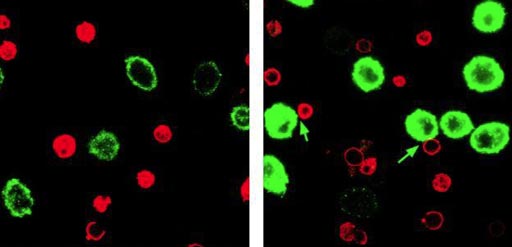Bifunctional Nanoparticles Show Potential in Cancer Models
By LabMedica International staff writers
Posted on 19 Jun 2017
To be successful, an immunotherapeutic approach for treating cancer must overcome the immunosuppressive effects of the tumor microenvironment; a novel bifunctional nanoparticle does just that.Posted on 19 Jun 2017
To counteract the immunosuppressive tumor microenvironment, investigators at Johns Hopkins University (Baltimore, MD, USA) coated 100 nanometers in diameter paramagnetic iron particles with two different kinds of antibodies. The pair of antibodies was crafted to block simultaneously the inhibitory checkpoint PD-L1 (programmed death ligand 1) signal while stimulating T-cells via the 4-1BB co-stimulatory pathway. The investigators coined the term "immunoswitch" to describe these novel bifunctional particles.

Image: A photomicrograph showing T-cells (red) and tumor cells (green) incubated with control particles (left) or immunoswitch particles (right). The T-cells that have attached to tumor cells are indicated by green arrows (Photo courtesy of Alyssa Kosmides, Johns Hopkins University).
The investigators tested immunoswitch therapy in several mouse melanoma and colon cancer models. They reported in the June 7, 2017, online edition of the journal ACS Nano that this treatment significantly delayed tumor growth and extended survival in multiple mouse cancer models in comparison to the use of soluble antibodies or nanoparticles separately conjugated with the inhibitory and stimulating antibodies. The immunoswitch-treated mice developed tumors that were nearly 75% smaller than those in animals that received no treatment, whereas soluble antibody only reduced tumor growth by approximately 25%. Half of immunoswitch-treated mice survived after 30 days, whereas all untreated mice died by day 22.
Immunoswitch particles enhanced effector-target cell conjugation and bypassed the requirement for previous knowledge of tumor antigens. Furthermore, the use of the immunoswitch nanoparticles resulted in an increased density, specificity, and in vivo functionality of tumor-infiltrating CD8+ T-cells.
"Immunotherapies have significant potential and yet room for improvement," said senior author Dr. Jonathan P. Schneck, professor of pathology at Johns Hopkins University. "The improvement here was to make, for the first time, a nanoparticle that can interact simultaneously with multiple types of cells in the complex tumor microenvironment, dramatically increasing its effectiveness. The double-duty immunoswitch particles were clearly more effective than a mixture of nanoparticles that each targeted just one protein and acted in a synergistic fashion, but we do not yet know why. It may be that the immunoswitch particles' success comes from bringing T-cells and their targeted tumor cells into close proximity."
Related Links:
Johns Hopkins University













